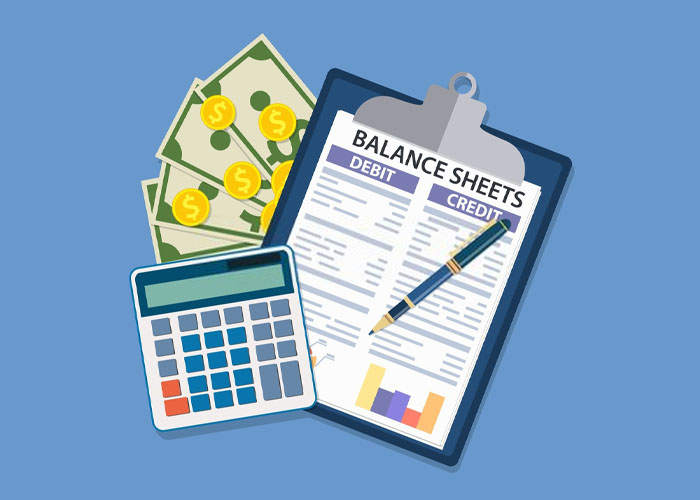
The balance sheet is one of the most important financial statements of a joint-stock company, which is also called the statement of financial position. This financial statement is a report that shows how much assets and liabilities the company had and how much equity was at a certain time. In fact, the balance sheet is a report that shows the company’s financial status as a snapshot at a specific time and is published at the end of quarterly and annual financial periods. In order to fully learn these concepts, we suggest you read the stock market training article on Rahvard website.
Assets, liabilities, and equity are actually small accounts that show the state of the company’s financial profile. These small accounts are different according to the type of companies and their activities and have different components; But the balance sheet equation will be maintained in all balance sheets.
The balance sheet equation, which is also called the accounting equation, is the main basis of modern accounting and applies to all transactions. In this equation, assets and total liabilities and equity are equal
Labels: Order to build a Forex robot , Build a stock trading robot , Build a trading robot , Trader robot design , Free Forex Robot , Forex robot programming , Forex Expert Making Tutorial , Build a trading robot with Python , Download Forex Trading Robot , Buy Forex Trader Robot , Automated Forex Robot , Free stock trading robot , Learn how to build a Forex trading robot , Alpari trading robot , Forex robot for Android , MetaTrader robot design , MetaTrader robot programming , Forex robot design , Forex robot programming , Automated trading
Assets = Liabilities + Capital (Equity)
In fact, the basis of preparing the balance sheet is to provide information and details of the accounting equation in a regular format. In the balance sheet, like the accounting equation, assets are listed on the right side and liabilities and equity are listed on the left side.
What items does the balance sheet consist of?
The most important part of a balance sheet is the two columns on the left and right sides, which must be aligned with each other and conform to the accounting equation.
1. Assets column
In the right column of the balance sheet, the assets of an economic enterprise, based on a rule called decreasing liquidity, are first placed in the order of liquidity power, and then the items that are more stable will be placed at the end of the balance sheet.
The assets themselves include two parts:
Current assets
Assets such as cash, securities that can be sold, inventory, accounts receivable, advance payments, liquidable deposit accounts, etc., which have higher liquidity and are liquidated in less than one fiscal year, are called current assets.
Non-current assets
Assets such as fixed assets, long-term investments, intangible assets, etc., which are less liquid than current assets and cannot be liquidated in less than one fiscal year, are non-current assets.
2. Debts and equity column
This column includes two sections, liabilities and equity. Debts are actually debts of various natures, such as debts to suppliers, investors’ dividends, salaries and wages, rents, etc., which the company is obliged to pay.
Liabilities, like assets, include two categories of current and non-current liabilities and are included in the balance sheet in order of payment due date:
Current liabilities
Debts such as payable interest, rent, taxes, facility payments, advances, salaries and wages, etc., whose payment date is less than one fiscal year, are called current debts.
Non-current liabilities
Debts such as installment tax debts, long-term debts, interest and principal of bonds, etc., which are not due for more than one financial year, are called non-current debts.
3. Equity
The next part of the column on the left of the balance sheet is the money that belongs to the owners of the shares of the economic enterprise in question, and it is also referred to as net assets. This amount is obtained from the difference between a company’s assets and liabilities, except equity, and is also known as equity. Analysts examine the financial health of a company by examining this part of the balance sheet.
What are the components of the balance sheet?
In addition to what was said about the balance sheet, there are other details that are part of the balance sheet.
-
The title of the balance sheet
The title of the balance sheet includes three parts. The first part is the full name of the economic unit, which is written in the first line, the second part is the name of the report, which is the financial statement, and is written in the second line. The third part is the reporting date, that is, the last day of the financial period.
-
Balance sheet measurement unit
The unit of measurement is one of the important components of the balance sheet, in Iran, rial is considered as the unit of measurement in the form of financial status.
-
Total accounts in the balance sheet
The last item is the sum of the accounts, i.e. the sum of the components of the first column (assets) and the second column (sum of liabilities and equity). Finally, under the sum of these two columns in the balance sheet, we draw two equal lines that indicate its closure and their sum should also be equal.
How to interpret the balance sheet?
Due to the fact that the balance sheet shows the annual performance of a company on the last day of the financial period, it does not have the ability to show the long-term trends and changes of the company for more than one year. To check the long-term trend of the company, the current balance sheet of the company should be compared and analyzed with the past balance sheets.
Also, by comparing the balance sheet of the company with other industrial companies in which it operates, a proper analysis of the state of the industry and the company can be reached. With the help of other financial statements, more interpretations of the current state of the company can be obtained. On the other hand, by examining the parameters in the balance sheet and obtaining important financial ratios, the health of the company’s activity can be checked.
The difference between the balance sheet and the profit and loss statement and cash flow
A company’s balance sheet is like a snapshot of assets, liabilities, and equity, and generally shows a company’s financial position at a moment in time. But the statement of profit and loss and cash flow is like a movie of the company’s situation in a period of three months or one year.
For example, in the balance sheet, the financial status of the company is reported at a specific time, for example, June 30, 1401, but in the profit and loss and cash flow statements, this report belongs to the period of the first quarter of 1401.
How to view the balance sheets of companies on the Rahavard site
To check a company’s balance sheet, you can visit the Rahvard site, search for the symbol of your desired company from the search menu, and view the company’s balance sheet from the basic tab.
As you can see, it is possible to view the company’s balance sheet in two ways: “Total” and “Interim”. In assembly mode, the company’s balance sheet is displayed annually.
In interim mode, the balance sheet is displayed quarterly. It should be noted that it is possible to receive the balance sheet file in both Excel and CSV formats.
What are the types of balance sheet?
In terms of appearance, balance sheets can be presented in the following two ways:
form of account
As we mentioned earlier, the balance sheet consists of two columns and the shape of the account is in the form of the letter T. In this display method, assets are placed on the right side of the balance sheet, and debt and equity are placed in the left column, and it is also required to establish the accounting equation.
Report format
In this method of display, there is no column related to debt and equity, and all items are written in one column and in a report form. First, the assets, then the ownership rights, and finally the liabilities are listed in one column.
In Iran, the form of balance sheet account was used for presentation, but recently, the balance sheet of many companies is presented in the form of a report. The types of balance sheets can be classified differently in terms of details and items included in it.
The general goal of all companies in preparing the balance sheet is to specify the financial status of the company for employees, management and investors who intend to invest in the company, but their preparation differs according to the type of activity of each company. The main difference between balance sheets is in details such as amounts, types of accounts, and such cases, which we will examine.
-
Balance sheets of commercial companies
Considering that they do not have a specific production activity, the balance sheet of commercial companies includes details such as gross profit and loss accounts and net profit and loss accounts, operating accounts, etc.
-
Balance sheets of service companies
In service companies, like commercial companies, there is no product production and movement; Therefore, most of the accounts are related to the cost of providing services, profit from providing services, salaries and wages of personnel, etc.
-
Balance sheets of contracting companies
The activity of contracting companies is receiving project capital from the employer at different stages of project completion, closing short-term and long-term contracts for various projects, high commitments, etc. These companies have the possibility to simultaneously have the nature of service, production, etc.
-
Balance sheets of joint stock companies
Companies are registered as a public or private joint-stock company. The balance sheet of these companies is not different from other companies and is prepared in the same way.
-
Balance sheet of stock exchange companies
The balance sheet of stock exchange companies shows the records of the company’s activity, the current financial situation of the company and its ability to make profit, which is the basis for the analysis and decision making of many stock market operators. Therefore, the balance sheets of these companies are not different from other companies in terms of accounting principles, and there is a special importance only in the implementation of the principle of information disclosure and transparency.
This is because many shareholders will trade based on this information and this issue has a great impact on the value of the company. It should be noted that the balance sheets of listed companies must be approved by competent authorities.
-
Balance sheets of banks
The main capital of the country is in the hands of banks, and it is the banks that direct this capital. Banks engage in economic activities by using the major capital they have in hand, and this high amount of money has caused their activity to affect the amount of reduction or growth of public assets. Therefore, the balance sheet of banks is of special importance due to the fact that depositors, by examining the activity of banks, evaluate their success rate in the field of their economic activities. Therefore, the balance sheet of banks shows bank assets and liabilities, and changes in these parameters can change the economy at micro and macro levels and lead to major changes.
What is the use of the balance sheet?
A company’s balance sheet is a part of the company’s financial statements that is very useful; But its main use for investors comes from the effectiveness of this financial statement in fundamental analysis. Investors and fundamental analysts can use a company’s profit and loss statement, balance sheet, cash flow statement, and comprehensive profit and loss statement to examine whether there is a balance between the company’s liabilities, assets, and profitability.
The balance sheet shows the performance of a company in the past and indicates whether there is a possibility of the company’s growth in the future or not. On the other hand, by comparing and reviewing the balance sheet of a company for several consecutive years, it is possible to check the amount of change in its assets, liabilities and equity and predict the trend of these changes. Therefore, the basic and important application of the balance sheet is to give the ability to recognize and predict the profitability or loss making process of a company in the future.
What does the balance sheet tell you about a company?
The balance sheet is a financial report of the amount of assets, liabilities and equity. With the information in the balance sheet, financial ratios used in fundamental analysis can be calculated and interpreted according to the desired industry and the type of company’s activity. In this way, investors see a general perspective of the company’s situation and decide to invest in it. On the other hand, the balance sheet helps to gain a better insight into the company’s liquidity, its productivity and the influence of the company’s activity on the market and the economy.
How to write a balance sheet
Nowadays, various software are used to prepare the accounting balance sheet of companies, but it can also be prepared manually. To prepare a balance sheet manually, you must first determine the date and reporting period of your balance sheet. The balance sheet date is the last day of your reporting period. Because the financial period of most companies is usually from the beginning of April to the end of the year, therefore, the date of the annual report for most companies is 29 March.
In the next step, you need to specify your assets. Assets are usually listed on the balance sheet both individually and as total assets to make the analysis easier for the analyst. Assets are divided into two categories: current and non-current:
Current assets
- pre paids
- Inventories
- Trade receivables and other receivables
- Short-term marketable securities
- cash
Non-current assets
- Tangible fixed assets
- Investment in real estate
- Intangible assets
- Long-term marketable securities
- Long-term receivables
- Other assets
First, write the current and non-current assets separately in the right column and then include their total in the balance sheet. Next, you need to identify your debts. Do this in the same way for the debts and first separately and then include the total debts in the balance sheet.
Current liabilities
- Trade payables and other payables
- Tax paid
- Dividends payable
- financial facilities
- resources
- prepayments
Non-current liabilities
- Long-term payables
- Long-term financial facilities
- Reserve employee termination benefits
Now you need to calculate the equity. If the balance sheet you are preparing is for a private company that is owned by one owner, calculating equity will be a very simple task. But if the company is a public company and is owned by several major and minor owners, the calculation of this parameter will be a little more complicated. But in general, the common items that are available in the balance sheet are:
- Fund
- Capital increase in progress
- spend on shares
- Spending on treasury shares
- Legal reserve
- Other reserves
- Surplus revaluation of assets
- Foreign exchange rate difference
- Accumulated profit (loss).
- Treasury shares
Add total liabilities to total equity and write at the bottom of the column. Finally, the sum of the two columns on both sides of the balance sheet table must be equal.
The most important parts of the balance sheet in fundamental analysis
All parts of the balance sheet have their own importance; But this importance may be different according to the type of use of each segment in the analysis of the company. According to financial analysts and experts, the cash balance is the most important part of the balance sheet, and accounts receivable, short-term investment, investment in real estate, and debt are in the next degrees of importance, respectively.
What is the biggest balance sheet problem?
The biggest problem of the balance sheet is that all its items are recorded in the balance sheet according to their book value, and the passage of time and inflation do not affect these recorded prices. This is especially true for fixed assets. For example, a property that was purchased 20 years ago for 50 million tomans and recorded in the balance sheet, after 20 years, it is still listed in the balance sheet with the same book value.
What are the events after the balance sheet date?
These financial events are actually the events that occurred between the date the financial period ended and the date the balance sheet was prepared, and they are classified as adjusting and non-adjusting events. Adjusting events are events that change transactions before the end of the financial period. Therefore, they should be included in the balance sheet.
What is the tax reserve in the balance sheet?
This part of debts is considered due to the difference between accounting principles and tax laws. The tax assigned to the company is considered a liability until it is determined and is recorded as a tax reserve in the books and balance sheet. Changing this amount means changing the estimate.
What is the cash balance reported on a company’s balance sheet?
One of the items that is reported in the balance sheet is the cash balance, which includes bank deposits, cash, salary and bank accounts and is considered a part of the company’s assets. It should be noted that the following items are not considered the company’s cash balance:
- Long-term uncollected claims such as uncollected checks
- Deposits with the broker for transactions
- Blocked or frozen bank funds
- Securities and stamps that are considered essential
Conclusion
The balance sheet is one of the financial statements that shows the financial status of the company in different financial periods. The balance sheet is actually a financial report of the company’s assets, liabilities and equity. With the information in the balance sheet, financial ratios used in fundamental analysis can be calculated and interpreted according to the industry and type of company’s activity. For additional information, we suggest you read the fundamental analysis training article.








Comments (0)